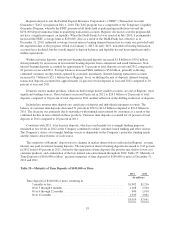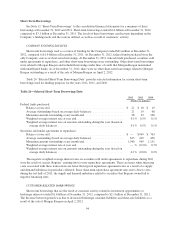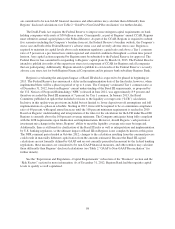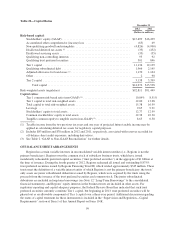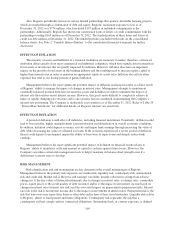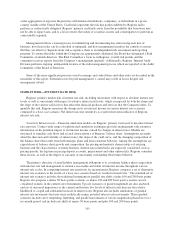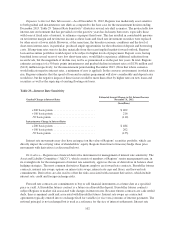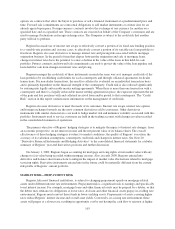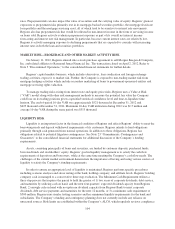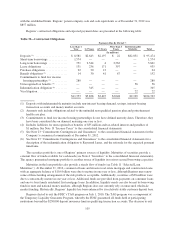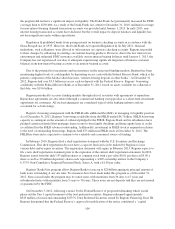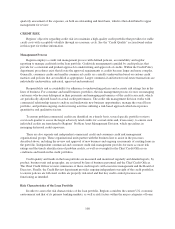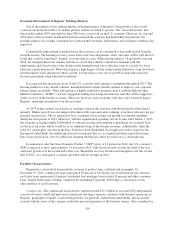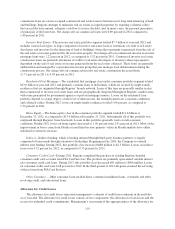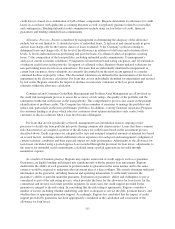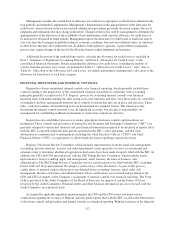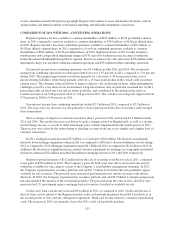Regions Bank 2012 Annual Report Download - page 119
Download and view the complete annual report
Please find page 119 of the 2012 Regions Bank annual report below. You can navigate through the pages in the report by either clicking on the pages listed below, or by using the keyword search tool below to find specific information within the annual report.options are contracts that allow the buyer to purchase or sell a financial instrument at a predetermined price and
time. Forward sale commitments are contractual obligations to sell market instruments at a future date for an
already agreed-upon price. Foreign currency contracts involve the exchange of one currency for another on a
specified date and at a specified rate. These contracts are executed on behalf of the Company’s customers and are
used to manage fluctuations in foreign exchange rates. The Company is subject to the credit risk that another
party will fail to perform.
Regions has made use of interest rate swaps to effectively convert a portion of its fixed-rate funding position
to a variable-rate position and, in some cases, to effectively convert a portion of its variable-rate loan portfolio to
fixed-rate. Regions also uses derivatives to manage interest rate and pricing risk associated with its mortgage
origination business. In the period of time that elapses between the origination and sale of mortgage loans,
changes in interest rates have the potential to cause a decline in the value of the loans in this held-for-sale
portfolio. Futures contracts and forward sale commitments are used to protect the value of the loan pipeline and
loans held for sale from changes in interest rates and pricing.
Regions manages the credit risk of these instruments in much the same way as it manages credit risk of the
loan portfolios by establishing credit limits for each counterparty and through collateral agreements for dealer
transactions. For non-dealer transactions, the need for collateral is evaluated on an individual transaction basis
and is primarily dependent on the financial strength of the counterparty. Credit risk is also reduced significantly
by entering into legally enforceable master netting agreements. When there is more than one transaction with a
counterparty and there is a legally enforceable master netting agreement in place, the exposure represents the net
of the gain and loss positions with and collateral received from and/or posted to that counterparty. The “Credit
Risk” section in this report contains more information on the management of credit risk.
Regions also uses derivatives to meet the needs of its customers. Interest rate swaps, interest rate options
and foreign exchange forwards are the most common derivatives sold to customers. Other derivatives
instruments with similar characteristics are used to hedge market risk and minimize volatility associated with this
portfolio. Instruments used to service customers are held in the trading account, with changes in value recorded
in the consolidated statements of operations.
The primary objective of Regions’ hedging strategies is to mitigate the impact of interest rate changes, from
an economic perspective, on net interest income and the net present value of its balance sheet. The overall
effectiveness of these hedging strategies is subject to market conditions, the quality of Regions’ execution, the
accuracy of its valuation assumptions, counterparty credit risk and changes in interest rates. See Note 20
“Derivative Financial Instruments and Hedging Activities” to the consolidated financial statements for a tabular
summary of Regions’ year-end derivatives positions and further discussion.
On January 1, 2009, Regions began accounting for mortgage servicing rights at fair market value with any
changes to fair value being recorded within mortgage income. Also, in early 2009, Regions entered into
derivative and balance sheet transactions to mitigate the impact of market value fluctuations related to mortgage
servicing rights. Derivative instruments entered into in the future could be materially different from the current
risk profile of Regions’ current portfolio.
MARKET RISK—PREPAYMENT RISK
Regions, like most financial institutions, is subject to changing prepayment speeds on mortgage-related
assets under different interest rate environments. Prepayment risk is a significant risk to earnings and specifically
to net interest income. For example, mortgage loans and other financial assets may be prepaid by a debtor, so that
the debtor may refinance its obligations at lower rates. As loans and other financial assets prepay in a falling rate
environment, Regions must reinvest these funds in lower-yielding assets. Prepayments of assets carrying higher
rates reduce Regions’ interest income and overall asset yields. Conversely, in a rising rate environment, these
assets will prepay at a slower rate, resulting in opportunity cost by not having the cash flow to reinvest at higher
103


